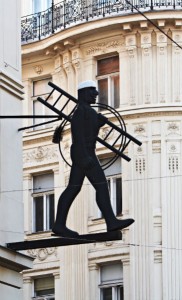History of Chimney Sweeping
The profession of chimney sweep dates back as far as the year 1200. This is when people in Britain began changing over from a large fire in the center of a large room to a series of smaller fires in each room to heat their homes. In doing so they connected all these flues and chimneys together into an elaborate maze of pipes that ran throughout the home. Once the fuel of choice switched from wood to coal soot buildup became a huge problem. Thus the need for chimney sweeping began.

Chimney sweeps have been necessary for hundreds of years, as heating living quarters is a constant for humans.
The process of sweeping a chimney has changed drastically since its inception. Originally chimneys were swept by hand by children. These children were indentured to a master sweep who, for all intents and purposes, owned them until they reached adulthood. These children would usually be orphans or poor children who were sold by their parents into the system. The master sweep would train them in the processes of clearing soot from a chimney and send them into the intricate tunnel system of chimneys in a building to do the dirty work. These children would shimmy up the chimney using their backs and knees and scrape the caked soot from the sides using a stiff brush. This caused their knees to become bruised and scraped so the master sweep would frequently use a brush and brine to harden up the knees to keep them from wearing out as easily. If a child was too scared to up a chimney some master sweeps would light a small fire to “convince” them to head upwards. Occasionally the children would become stuck and have to be removed. In some unfortunate circumstances the children would suffocate on the soot as they struggled to free themselves.
In 1788 the Chimney Sweepers Act of 1788 was passed to regulate the practices of master sweeps and their apprentices. This act limited the number of apprentices a master sweep could have and made sure that they were at least 8 years old. This legislation was largely not enforced and it wasn’t until 1834 that real change came about. This is when the Chimney Sweepers Act 1834 was passed. It required that an apprentice sweep had to go in front of a magistrate and declare they were “willing and desirous”. They also had to be at least 14 years old and were prohibited from climbing chimneys to extinguish fires. In 1840 it became illegal for anyone under 21 to sweep chimneys and after the death of a 12 year old boy in 1875 who was sweeping a chimney was ruled manslaughter an act was passed that required all master sweeps to register with the police in order to do business.
Since then the process of sweeping has become much more safe and humane. Now a single chimney sweep is often able to sweep an entire chimney by themselves. They will send a camera up the chimney to find any trouble spots and use a long extendable brush and industrial vacuum to clean up. Long gone are the days of indentured servitude and soot-soiled faces but the need for chimney sweeping is as present as ever. Although the origins of this profession are less than glamorous it has evolved into a noble profession. Throughout history chimney sweeps have done the necessary dirty work to keep buildings safe and clean. This has not changed. Keep your home safe and support your local chimney sweep. Call about having your chimney cleaned today!
